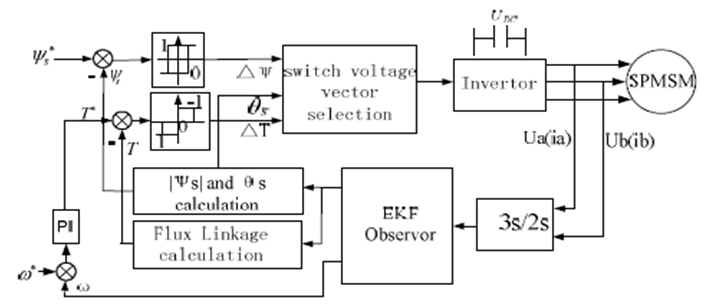PMSM Speed Sensor less Direct
Torque Control Based On EKF
ABSTRACT
System
with mechanical speed sensor has lower reliability and higher cost. Traditional
direct torque control method has disadvantages of big ripples on current and
flux linkage and torque. To solve these problems, the Extended Kalman Filter is
established to estimate both stator flux linkage and rotor speed. Therefore,
speed sensorless direct torque control for surface permanent magnet synchronous
motor is realized. Simulation results have shown that the advantage of direct torque
control method such as rapid torque response is maintained, at the same time,
the system based on EKF is robust to motor parameters and load disturbance. The
dynamic and static performances are dramatically improved.
KEYWORDS
1.
Direct torque
control
2.
Permanent
magnet
3.
Synchronous
motor (PMSM)
4.
Extended
kalman filter (EKF)
5.
Stator flux
linkage observation
6.
Speed
sensorless control
SOFTWARE:
MATLAB/SIMULINK
BLOCK DIAGRAM:
Figure 1. Schematic diagram of
speed sensorless DTC control for SPMSM based on EKF
CONCLUSION:
Speed sensorless DTC control based on EKF
for SPMSM is proposed. For a relatively accurate SPMSM model, flux linkage and
rotor speed and rotor position can be estimated more precisely by EKF
algorithm. Ripples on torque and stator flux are reduced. The motor start
problems are solved as EKF do not need accurate initial rotor position
information to achieve observer stability convergence. DTC control for PMSM
based on EKF has just begun. Many places are imperfect and need for further
study.
REFERENCES:
[1]
L.Zhong, M.F.Rahman, W.Y. Hu , K.W.Lim, “Analysis of direct torque control in
permanent magnet synchronous motor drives,” IEEE Trans. On Power Electronics,
1997, 13(5), pp:528-536.
[2]
Jun Hu, Bin Wu. “New integration algorithms for estimating motor flux over a
wide speed range,” IEEE Trans. on Power Electronics, 1998, 13(5),pp:969-977.
[3]
Cenwei Shi, Jianqi Qiu, Mengjia Jin, “Study on the performance of different
direct torque control methods for permanent magnet synchronous machines,”
Proceeding of the Csee, 2005, 25(16),pp:141- 146.
[4]
Limei Wang, Yanping Gao. “Direct torque control for permanent magnet synchronous
motor based on space voltage vector pulse width modulation,” Journal of
Shenyang University of Technology, 2007,29(6), pp:613-617.
[5]
Zhiwu Huang, Yi Li, Xiaohong Nian, “Simulation of direct torque control based
on modified integrator,” Computer Simulation, 2007,24(02),pp:149-152.
